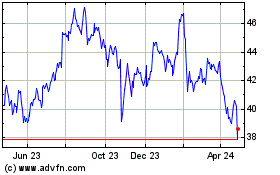By Shalini Ramachandran
Comcast Corp.'s first-quarter results offered a glimpse into why
the cable giant is jumping into the cutthroat wireless business:
Consumers don't want a landline phone anymore, limiting the appeal
of its lucrative "triple play" bundles.
The company lost 5,000 voice customers in the quarter, compared
with an addition of 102,000 in the year-ago quarter. Among just
residential voice customers, the decline was even more stark with a
loss of 27,000.
Offering wireless service will present a new way for Comcast to
encourage package upgrades and further diversify its business.
Earlier this month, Comcast unveiled a mobile offering for any
customer that subscribes to at least its internet service, debuting
unlimited data plans that in some cases undercut rivals.
While many investors have been focused on the company's upcoming
entry into the wireless business, Comcast still reported
better-than-expected financial results in the first quarter. Its
NBCUniversal arm posted strong earnings, buoyed by its filmed
entertainment unit.
On the cable side, Comcast added video and high-speed internet
customers, though additions slowed from the prior-year quarter. The
cable company added 42,000 residential and business video
customers, compared with the 53,000 it added in the prior-year
quarter. It added 429,000 broadband customers in the quarter
compared with 438,000 a year earlier.
Overall, net income rose to $2.6 billion, or 53 cents a share,
up from about $2.1 billion, or 43 cents a share, a year ago.
Revenue grew 8.9% to $20.5 billion.
Revenue and profit exceeded estimates from analysts, who were
projecting earnings of 44 cents a share on $20.1 billion in
revenue, according to Thomson Reuters. Comcast shares rose 2.9% to
$39.91 in midmorning trading.
Comcast's bottom line was helped by a decrease in effective
income-tax rate from the year earlier due to a new accounting
method it adopted. It also had favorable settlements of some state
tax audits, which resulted in a tax benefit. Guggenheim Securities
analyst Michael Morris estimated the tax benefits resulted in an
earnings-per-share boost of 4 cents.
As it seeks to highlight new lines of business, Comcast broke
out for the first time the number of customers who subscribe to its
security and home automation services: 957,000. In the quarter,
Comcast added 66,000 new home automation customers, up from 56,000
in the year-ago quarter.
The cable company's broadband and business services divisions
posted strong sales growth in the first quarter, lifting overall
revenue at the cable business -- which accounts for the bulk of
Comcast's top line -- by 5.8% to $12.9 billion.
Broadband revenue increased 10% to $3.6 billion, while
business-services revenue jumped almost 14% to $1.5 billion.
Landline voice revenue fell 3.6% to $863 million.
One weak spot in Comcast's first-quarter earnings was local
cable ad revenue, which declined 6.3%, below some analyst
estimates. Even excluding the impact of political advertising in
the year-earlier quarter, the decline was still 2.3%.
NBCUniversal Chief Executive Steve Burke, who is girding for the
"upfront" ad sales bazaar ahead of the new broadcast season, said
on a conference call with analysts that the "local advertising
market is weaker than the national one." Mr. Burke sounded an
optimistic note for the upfront and said NBCUniversal is going in
with the "strongest hand" it has had in a while, thanks in part to
Spanish broadcaster Telemundo, which has been gaining ground
against rival Univision.
At NBCUniversal, revenue rose 15% to $7.9 billion, helped by
strong growth at the filmed entertainment division, thanks to new
movies like "Fifty Shades Darker" and "Get Out." Filmed
entertainment brought in $1.98 billion in revenue, compared with
$1.38 billion in the year-ago quarter.
While the cable networks and broadcast TV units grew revenue and
earnings due to new carriage contracts and streaming content
licensing deals, they both continued to see lackluster ad sales
because of ratings softness. Cable networks' ad revenues declined
2.9% to $826 million, while broadcast TV ad revenue was essentially
flat at $1.3 billion.
Regarding Comcast's dive into the wireless business, many Wall
Street analysts and investors have been skeptical because its
service will rely on a five-year-old reseller agreement with rival
Verizon Communications Inc., raising the prospect that it isn't a
stable long-term solution. Wall Street was also taken by surprise
when Comcast meaningfully underspent analyst estimates in a recent
government auction of airwaves -- a sign that it is remaining
cautious.
While NBCUniversal sold broadcast spectrum back to the
government for $481.6 million in a recent reverse-auction, Comcast
bought $1.7 billion worth of wireless airwaves for cellphone
service in the auction that followed.
With the auction closing, investors are gaming out whether
Comcast ends up buying a wireless company instead. So far, company
executives have signaled that they are happy with their current
approach and don't think they need to buy a wireless carrier.
"We are taking a disciplined approach to the wireless business,"
Comcast Chief Executive Brian Roberts said on the call.
MoffettNathanson analyst Craig Moffett said in a research note
that Comcast's approach and its strong first-quarter results could
"put to rest all the mind-numbing speculation about deals, deals,
deals. But we doubt it."
Write to Shalini Ramachandran at
shalini.ramachandran@wsj.com
(END) Dow Jones Newswires
April 27, 2017 11:19 ET (15:19 GMT)
Copyright (c) 2017 Dow Jones & Company, Inc.
Comcast (NASDAQ:CMCSA)
Historical Stock Chart
From Mar 2024 to Apr 2024

Comcast (NASDAQ:CMCSA)
Historical Stock Chart
From Apr 2023 to Apr 2024
